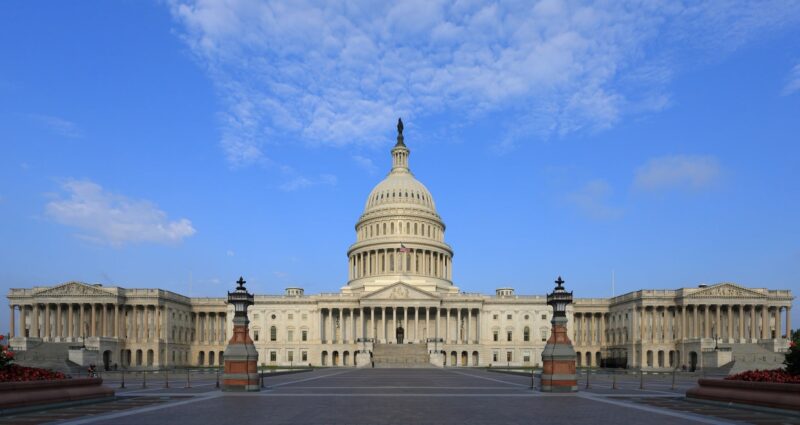
The fiscal 2018 omnibus spending bill President Donald Trump signed this week would give the National Nuclear Security Administration’s (NNSA) warhead refurbishment programs the 30-percent boost the White House requested, but it would also sustain a major nonproliferation construction project the agency has tried to cancel for three years.
Overall, the permanent, government-wide spending bill Congress had approved by early Friday would give the semiautonomous Department of Energy branch a little over $14.5 billion for fiscal 2018, which began on Oct. 1. That is 13 percent above the 2017 budget, which was extended about halfway through the current fiscal year under a series of stopgap spending measures.
The 2018 budget came in 5 percent higher than the $14 billion or so the White House requested, in part because Congress struck a deal earlier this year to erase spending caps set in place by the Budget Control Act of 2011. Agencies including the NNSA wrote their 2018 budget requests while the caps were still law, and draft 2018 appropriations bills that Congress produced last year stuck to the limits and would have given the NNSA about $14 billion.
The 2018 omnibus funds the agency’s four ongoing programs to extend the life of existing U.S. nuclear warheads and bombs at exactly the level the Donald Trump administration requested for this year: roughly $1.7 billion, or 30 percent more than in 2017.
Among these four programs, the largest increase from 2017 — 80 percent, to roughly $400 million a year — goes to the W80-4 life extension program. The W80 warhead tips existing air-launched cruise missiles, which will be replaced by the Long-Range Standoff Weapon that Lockheed Martin and Raytheon are designing for the Air Force. The Trump administration sought a big bump for the NNSA’s contribution to this weapon in 2018 so the upgraded warhead could be developed in sync with the service’s new missile.
But even as it plowed more money into the W80-4 life extension, Congress ordered a review of the program, according to the report appended to the 2018 omnibus. Specifically, report language directs the head of the Government Accountability Office “to conduct a review of the alternatives analyzed for the W80-4 life extension program, including whether the NNSA considered a wide range of alternatives for components and systems that would meet requirements.”
Meanwhile, and as expected, the omnibus continues to fund construction of the Mixed Oxide Fuel Fabrication Facility at the Savannah River Site in South Carolina: a massive plutonium-conversion plant the agency has sought to cancel in three successive budget requests. For 2018, funding for the facility would stay flat at $335 million. That is 20 percent more than the Donald Trump administration sought this fiscal year to wind the project down.
While Congress last year finally gave the NNSA a path to close the Mixed Oxide Fuel Fabrication Facility, the 2018 omnibus would forbid the agency from using this year’s appropriation to do so, until 30 days after it proves any alternative would cost no more than half the remaining cost of finishing and operating the plant.
CB&I AREVA MOX Services is building the Mixed Oxide Fuel Fabrication Facility under a contract awarded in 1999. The plant is designed to turn 34 metric tons of surplus weapon-usable plutonium into commercial nuclear reactor fuel.
The NNSA’s preferred alternative to the facility is called dilute-and-dispose: upgrading the Savannah River Site’s K-Area to chemically weaken the plutonium and make the material safe for burial in New Mexico. The DOE branch estimates those upgrades would cost roughly $1 billion. The omnibus would provide $10 million in initial funding for the upgrades, which is $1 million more than the White House sought.
The NNSA has already spent about $5 billion on the Mixed Oxide Fuel Fabrication Facility which, under the most optimistic estimates in the public sphere, will cost another $5 billion to finish by 2029.
There was relatively little ink devoted in the omnibus to another major nuclear construction project: the Uranium Processing Facility that Bechtel National is building at the Y-12 National Security Complex in Oak Ridge, Tenn.
The Uranium Processing Facility, a crucial cog in the ongoing 30-year nuclear modernization program started by the Barack Obama administration, would get just over $660 million in 2018: exactly what was requested, and a 15-percent raise from 2017. In congressional testimony Thursday, NNSA Administrator Lisa Gordon-Hagerty said the project was on track to finish in 2025 at a cost of no more than $6.5 billion, as the agency has promised Congress.
Unlike the stopgap continuing resolutions that have funded the NNSA and most of the rest of the government since Oct. 1, the omnibus is a permanent budget that provides funding agencies may use for new projects. The NNSA had a few that were supposed to start in this fiscal year but would presumably have been held up by the serial stopgap budgets.
However, the new low-yield, submarine-launched nuclear warhead called for in the Nuclear Posture Review the Trump administration released on Feb. 2 will not be among these. There is nothing in the omnibus for this project.
The NNSA has said the earliest it could start work on that weapon, a modified version of the existing W76 warhead, is fiscal 2019. To do that, the agency will have to get a new authorization from Congress and possibly make a supplemental appropriation request for fiscal 2019 — the budget request it sent to Capitol Hill in February sought no money for a low-yield warhead.
Within NNSA the Weapons Activities account — which manages the nation’s stockpile of nuclear warheads and materials and refurbishes aging U.S. warheads to keep them in the field — would get a 15-percent raise to more than $10.5 billion in 2018. The White House asked only for a 4-percent increase to that program this year.